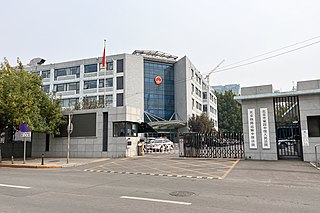
Donghuamen Subdistrict is a subdistrict at the center of Dongcheng District, Beijing, China. Tiananmen Square is located within this subdistrict. As of 2020, it has a total population of 38,090.

Jiaodaokou Subdistrict is a subdistrict in Dongcheng District, Beijing, China. It contains 7 communities within 1.57 km2 of land, as of 2020 it has a permanent population of 31,951.

Andingmen Subdistrict is a subdistrict in the northwestern part of Dongcheng District, Beijing, China. It contains 9 communities, covers 1.74 square kilometers of land, and has a population of 32,172 by the year 2020.

Beixinqiao Subdistrict is a subdistrict in the northern part of Dongcheng District, Beijing, China. The Yonghe Temple is located here. The subdistrict consists of 10 communities. By 2020 it has a total population of 55,449. Beijing Subway Line 5 runs through the subdistrict.

Chaoyangmen Subdistrict is a subdistrict in eastern portion of Dongcheng District, Beijing, China. It consists of 9 communities. As of 2020, this subdistrict has a population of 30,473.

Jianguomen Subdistrict is a subdistrict located in the eastern portion of the Dongcheng District, Beijing, China. It contains 9 residential communities within its 2.7 km2 area, and as of 2020 its totoal population is 33,094.

You'anmen Subdistrict is one of the 14 subdistricts of Fengtai District, Beijing, China. It is located on the eastern part of Fengtai, south of Baizhifang and Taoranting Subdistricts, west of Yongdingmenwai Subdistrict, north of Xiluoyuan Subdistrict, and east of Nanyuan, Lugouqiao and Taipingqiao Townships. The subdistrict is home to a population of 73,499 as of 2020.

Liuliqiao Subdistrict, formerly known as Lugouqiao Subdistrict, is one of the 14 subdistricts of Fengtai District, Beijing, China. It is situated on the north of Fengtai, south of Wangshoulu and Yangfangdian Townships, west of Taipingqiao Subdistrict, north of Fengtai Subdistrict, east of Babaoshan Subdistrict, and is contained by Lugouqiao Subdistrict. Liuliqiao has a population of 223,304 as of the 2020 census.

Lugouqiao Subdistrict, formerly Lugouqiao Township, is a subdistrict located at the northern end of Fengtai District, Beijing, China. It borders Lugu, Babaoshan, Taipingqiao and Guang'anmenwai Subdistricts to the north, You'anmen Subdistrict to the east, Xincun Subdistrict, Huaxiang and Wanpingcheng Townships to the south, Changxindian Town and Lugu Subdistrict to the west. It has a population of 112,087 within its administrative area as of the 2020 census.

Yungang Subdistrict is one of the fourteen subdistricts of Fengtai District, Beijing, China. It is located on the southwest of Fengtai, and borders Changxindian Town to the northeast, as well as Wangzuo Town to the southwest. It had a population of 34,537 in 2020.

Majiapu Subdistrict is a subdistrict on the eastern part of Fengtai District, Beijing, China. It borders Xiluoyuan Subdistrict to the north, Xiluoyuan and Dahongmen Subdistricts to the east, Nanyuan Township to the south, Xincun Subdistrict and Huaxiang Township to the west. As of 2020, it has a total population of 111,470.

Heyi Subdistrict is a subdistricts located on the southeast of Fengtai District, Beijing, China. It shares border with Nanyuan Township to the north, Jiugong Township to the east, Nanyuan Subdistrict and Township to the south and west. It has a total of 40,108 residents as of 2020.

Wanping Subdistrict, formerly known as Wanpingcheng Area, is a subdistrict in the northern part of Fengtai District, Beijing, China. It borders Lugu Subdistrict to the north, Lugouqiao Subdistrict and Huaxiang Township to the east, Huangcun Township to the south, Changyang Town and Changxindian Town to the west. The subdistrict had a population of 46,208 as of the 2020 census.

Huaxiang Subdistrict, or previously HuaxiangArea, is a subdistrict on the eastern side of Fengtai District, Beijing, China. In 2020 it had a population of 119,171

Beigong Town, formerly Changxindian Town, is a town within the Fengtai District of Beijing, China. It borders Yongding Township and Gucheng Subdistrict to the north, Lugu and Wanping Subdistricts to the east, Changyang Town to the south, Yungang Subdistrict and Wangzuo Town to the west, and contains Changxindian Subdistrict within it. Its population was 44,358 as of the year 2020.

Wangzuo Town a town on the southwest of Fengtai District, Beijing, China. It is bordering Yongding Township to the north, Beigong Town and Yungang Subdistrict to the east, Changyang Town, Gongcheng and Xilu Subdistricts to the south, Qinglonghu and Tanzhesi Towns to the west. The town had a population of 59,452 in 2020.

Babaoshan Subdistrict is a subdistrict on the southeast corner of Shijingshan District, Beijing, China. It borders Laoshan Subdistrict to the north, Wangshoulu Subdistrict to the east, Liuliqiao and Lugouqiao Subdistricts to the south, and Lugu Subdistrict to the west. As of 2020, it had a total population of 61,211.

Laoshan Subdistrict is a subdistrict on the southeast of Shijingshan District, Beijing, China. It borders Tiancunlu Subdistrict to the north, Wangshoulu and Yongdinglu Subdistricts to the east, Lugu and Babaoshan Subdistricts to the south, and Bajiao Subdistrict to the west. In 2020, it had a population of 40,023.

Bajiao Subdistrict is a subdistrict on the southeastern part of Shijingshan District, Beijing, China. It borders Pingguoyuan Subdistrict to its north, Sijiqing, Tiancunlu and Laoshan Subdistricts to its east, Lugu Subdistrict to its south, and Gucheng Subdistrict to its west. As of 2020, its population was 110,929.

Yongding Road Subdistrict is a subdistrict situated on the south side of Haidian District, Beijing, China. It borders Tiancun Road Subdistrict in the north, Wanshou Road Subdistrict in the east and south, and Laoshan Subdistrict to the west. As of 2020, it had 90,879 people residing within it.























